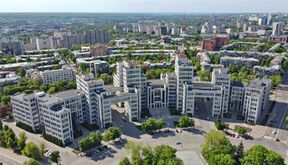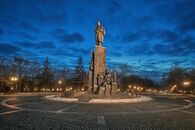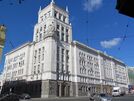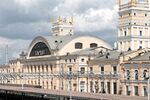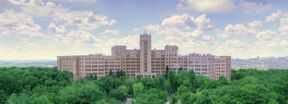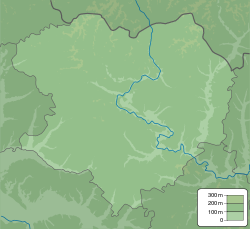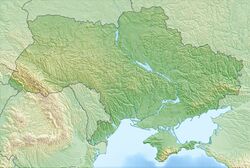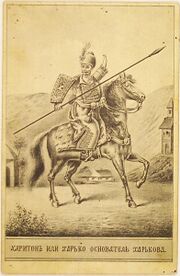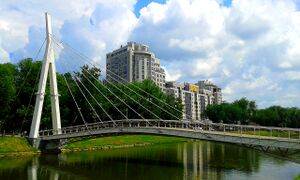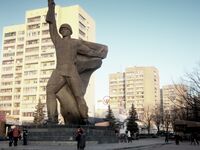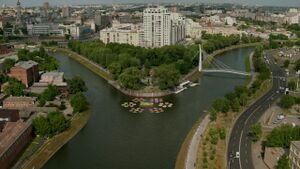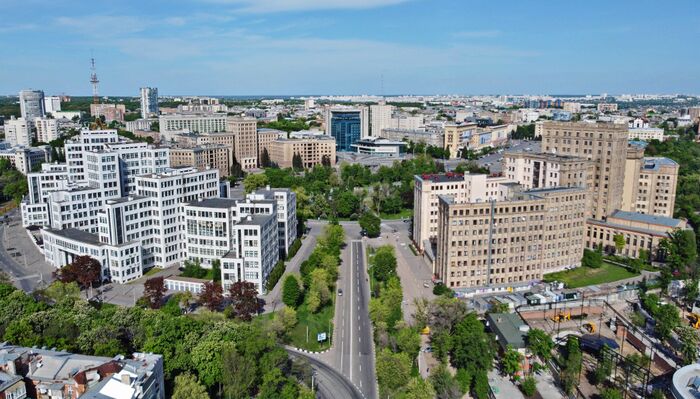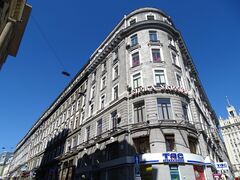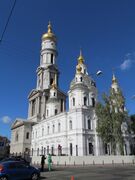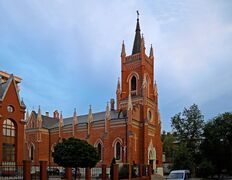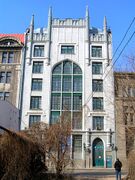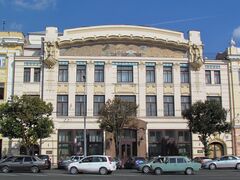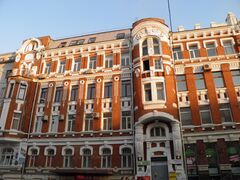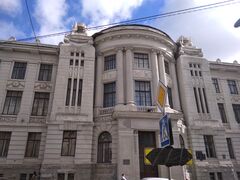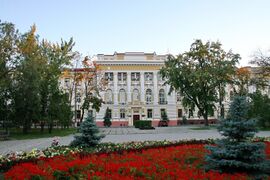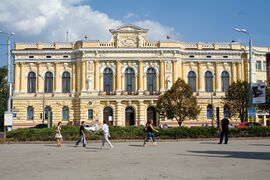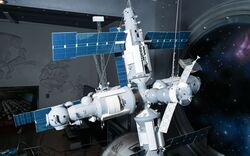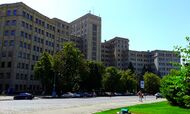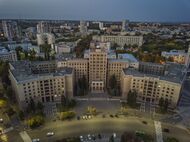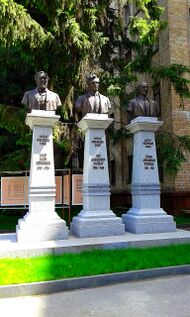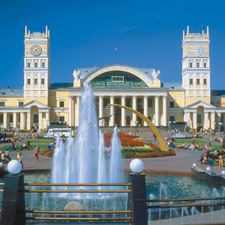خاركيڤ
خاركيڤ (خاركوڤ)
Харків (Харьков) | |
|---|---|
| الترجمة اللفظية بالـ بالأوكرانية | |
| • باللغة الوطنية | Kharkiv |
| • ALA-LC | Kharkiv |
| • BGN/PCGN | Kharkiv |
| • عالمياً | Charkiv |
عكس عقارب الساعة: درچپروم، كاتدرائية الصعود، مجلس مدينة خاركيڤ، جامعة خاركيڤ الوطنية، محطة سكك حديد خاركيڤ، نصب تاراس شڤتشنكو التذكاري | |
|
| |
| الكنية: المدينة الذكية | |
| الإحداثيات: 49°59′33″N 36°13′52″E / 49.99250°N 36.23111°ECoordinates: 49°59′33″N 36°13′52″E / 49.99250°N 36.23111°E | |
| البلد | |
| الأوبلاست | |
| الريون | رايون خاركيڤ |
| التأسيس | 1654[1] |
| الضواحي | قائمة من 9[2]
|
| الحكومة | |
| • العمدة | إهور ترخوڤ[3] (كتلة كارنز - خاركيڤ الناجحة[4]) |
| المساحة | |
| • مدينة | 350 كم² (140 ميل²) |
| المنسوب | 152 m (499 ft) |
| التعداد (2021) | |
| • مدينة | 1٬433٬886 |
| • الكثافة | 4٬500/km2 (12٬000/sq mi) |
| • العمرانية | 2٫032٫400 |
| صفة المواطن | خاركيڤي [5] |
| منطقة التوقيت | UTC+2 (EET) |
| • الصيف (التوقيت الصيفي) | UTC+3 (EEST) |
| Postal code | 61001–61499 |
| لوحة المركبات | AX, KX, ХА (old), 21 (old) |
| المدن الشقيقة | بلگورود، بولونيا، سنسناتي، كاوناس، ليل (فرنسا)، موسكو، نژني نوڤگورود، نورمبرگ، پوزنان، سانت پطرسبورگ، تيانجين، ريزه، كوتايسي، ڤارنا |
| الموقع الإلكتروني | http://www.city.kharkov.ua |
خاركيڤ (أوكرانية: Ха́рків؛ IPA: [ˈxɑrkiu̯](![]() استمع))، وتُعرف أيضاً بإسم خاركوڤ (روسية: Харькoв؛ IPA: [ˈxarʲkəf]) هي ثاني أكبر مدينة في أوكرانيا من ناحية المساحة وعدد السكان، وبلدية في أوكرانيا.[6] وتقع في شمال شرق البلد، وهي أكبر مدينة في منطقة سلوبوژانشينا. وخاركوف هي المركز الإداري لأوبلاست خاركيڤ. أحدث تعداد للسكان كان 1,433,886 (2021 est.).[7]
استمع))، وتُعرف أيضاً بإسم خاركوڤ (روسية: Харькoв؛ IPA: [ˈxarʲkəf]) هي ثاني أكبر مدينة في أوكرانيا من ناحية المساحة وعدد السكان، وبلدية في أوكرانيا.[6] وتقع في شمال شرق البلد، وهي أكبر مدينة في منطقة سلوبوژانشينا. وخاركوف هي المركز الإداري لأوبلاست خاركيڤ. أحدث تعداد للسكان كان 1,433,886 (2021 est.).[7]
وهي أكبر مركز صناعي وعلمي وثقافي. أسست هذه المدينة في القرن السابع عشر (1656 - 1654 م) وبقيت عاصمة لأوكرانيا حتى مطلع الثلاثينات من القرن الماضي. يزيد عدد سكان هذه المدينة على 1.5 مليون نسمة، يوجد في مدينة خاركوف حوالي 500 نصب تذكاري، متاحف، ومسارح وقاعات عرض . أما أنفاق المترو (قطارات تحت الأرض) والتي يعود فن معماريتها إلى أنفاق موسكو، فهي أبرز ملامح هذه المدينة. ومدينة خاركوف هي أكبر مدينة طلابية، حيث يوجد فيها أكثر من 20 معهد تعليمي عالي. وتعد من المناطق الباردة نسبيا وقد تتدنى درجات الحرارة إلى الثلاثين تحت الصفر وهناك جالية عربية كبيرة وخاصة من الأردنيين.
تأسست خاركيڤ عام 1564 بإنشاء حصن خاركيڤ، وبعد هذه البدايات المتواضعة، نمت لتصبح مركزًا رئيسيًا للصناعة والتجارة والثقافة الأوكرانية في الإمبراطورية الروسية. في بداية القرن العشرين، كانت المدينة ذات غالبية روسية ولكن بعد السياسة التي انتهجتها االحكومة السوڤيتية في أوكرانيا أصبحت المدينة مأهولة بشكل رئيسي من قبل الأوكرانيين مع عدد كبير من الروس.[8][9] كانت خاركيڤ أول عاصمة لجمهورية أوكرانيا الاشتراكية السوڤيتية، من ديسمبر 1919 حتى يناير 1934، بعدها انتقلت العاصمة إلى كييڤ.[10]
في الوقت الحاضر، تعد خاركيڤ مركزًا ثقافيًا وعلميًا وتعليميًا وصناعيًا رئيسيًا في أوكرانيا، وتضم العديد من المتاحف والمسارح والمكتبات، بما في ذلك كاتدرائية البشارة وكاتدرائية دورميتيون، ومبنى درچپروم في ساحة الحرية، وجامعة خاركيڤ الوطنية. كانت خاركيڤ المدينة المضيفة لبطولة كأس الأمم الأوروبية 2012.
تلعب الصناعة دورًا مهمًا في اقتصاد خاركيڤ، وهي متخصصة بشكل أساسي في الآلات والإلكترونيات. هناك المئات من المنشآت الصناعية في جميع أنحاء المدينة، بما في ذلك مكتب تصميم موروزوڤ، وصنع ماليشڤ للدبابات (رواد إنتاج الدبابات العالم من الثلاثينيات حتى الثمانينيات)؛ خرترون (الفضاء الجوي، محطة الطاقة النووية والأتمتة الإلكترونيات)؛ تربوأتوم (توربينات محطات الطاقة المائية والحرارية والنووية)؛ وأنتونوڤ (مصنع تصنيع الطائرات متعدد الأغراض).
. . . . . . . . . . . . . . . . . . . . . . . . . . . . . . . . . . . . . . . . . . . . . . . . . . . . . . . . . . . . . . . . . . . . . . . . . . . . . . . . . . . . . . . . . . . . . . . . . . . . . . . . . . . . . . . . . . . . . . . . . . . . . . . . . . . . . . . . . . . . . . . . . . . . . . . . . . . . . . . . . . . . . . . .
التاريخ
التاريخ المبكر
عُثر في المنطقة قطع أثرية ثقافية تعود إلى العصر البرونزي، بالإضافة إلى تلك التي تعود إلى المستوطنين السكوذيين والسرمتيين. كان الموقع جزءًا من منطقة حضارة تشرنياخوڤ خلال القرنين الثاني والسادس. كانت قلعة خزار في "ڤرنخنياي سالتوڤو" (القرنان الثامن إلى العاشر) على بعد حوالي 25 ميلاً شرق موقع المدينة الحديثة، بالقرب من ستاري سالتيڤ.[11] أثناء القرن الثاني عشر، كانت جزءاً من أراضي الكومان.
تأسست القلعة من قبل المستوطنين الذين فروا من الحرب التي اجتاحت الضفة اليمنى لأوكرانيا عام 1654 (انظر انتفاضة خملنيتسكي).[1] في السنوات السابقة كانت المنطقة ذات كثافة سكانية منخفضة من هتمانية القوزاق.[12] جاءت مجموعة السكان على ضفاف نهري لوپانان وخاركيڤ حيث توجد مستوطنة مهجورة.[13] حسب الوثائق الأرشيفية، فإن زعيم المستوطنين الجدد كان الأتامان إيڤان كريڤوشليك.[1]
سُميت القلعة على اسم نهر خاركيڤ. هناك أصل شعبي للاسم يربط اسم كل من المدينة والنهر بالمؤسس القوزاقي الأسطوري المسمى "خاركو"[14] (صيغة مصغرة لاسم خاريتون، أوكرانية: Харитон, romanized: Khariton،[1] أو زخاريا، أوكرانية: Захарій, romanized: Zakharii).[15] في الخمسينيات أثبت ج. ب. رودنيكي أن اسم النهر وُجد قبل تأسيس القلعة في أواخر القرن السادس عشر.[16]
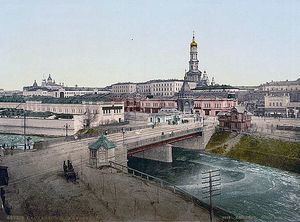
في البداية كانت المستوطنة تتمتع بالحكم الذاتي تحت سلطة ڤويڤود من تشوخيڤ أي 40 كم إلى الشرق.[13] وكان أول ڤويڤود معين من موسكو هو ڤويين سليفونتوڤ عام 1656 والذي بدأ ببناء أوستروگ (حصن) محلي.[13] في تلك الفترة كان سكان خاركيڤ أكثر بقليل من 1000 نسمة، نصفهم من القوزاق المحليين، بينما أتى سليفونتوڤ برفقته حامية موسكو والتي تضم 70 عسكرياً آخر.[13]
أُستبدل أول ڤويڤود لخاركيڤڤ بعد سنتين بسبب الشكوى المستمرة من أن المحليين يرفضون التعاون لبناء الحصن.[13] أصبحت خاركيڤ أيضاً مركزاً لفوج قوزاق سلوبودا المحلي حيث كانت المنطقة المحيطة بقلعة بلگورود مكتظة بالجنود. مع إعادة توطين المنطقة من قبل الأوكرانيين أصبحت تُعرف باسم سلوبودا أوكرانيا، والتي كان معظمها مدرجًا تحت سلطة رارياد پريكاز (التعيين العسكري) برئاسة مسؤول محلي من بلگورود. بحلول عام 1657، كان لمستوطنة خاركيڤ حصناً[13] بممرات تحت الأرض.
عام 1658، عُين إيڤان أوفروسيموڤ في منصب الڤويڤود الجديد، والذي عمل على إجبار السكان المحليين على تقبيل الصليب لإظهار الولاء للقيصر الروسي.[13] رفض المحليون بقيادة الأتومان إيڤان كريڤوشليك.[13] ومع ذلك، مع انتخاب الأوتمان الجديد تيميش لاڤرينوڤ، أرسل المجلس (hromada) طلبًا إلى القيصر لإنشاء سوق افتراض محلي، موقعاً من رؤساء كنائس خاركيڤ (كاتدرائية الصعود وأبرشيات البشارة والثالوث).[13] كانت العلاقات مع تشوخيڤ المجاورة في بعض الأحيان غير ودية وغالبًا ما يتم تهدئة منازعاتهم بالقوة.[13]
في الوقت نفسه، أصبحت خاركيڤ مركزاً لسلوبودا أوكرانيا.[17]
حصن خاركيڤ
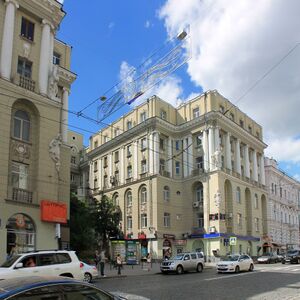
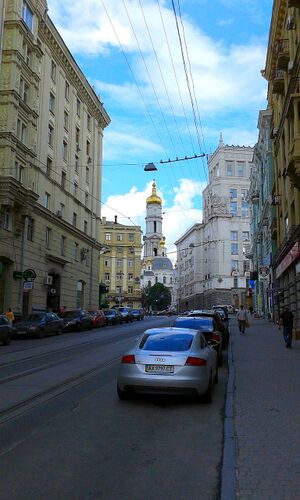
أقيمت قلعة خاركيڤ حول كاتدرائية الصعود وكانت قلعتها في جامع هل.[13] كانت بين شوارع اليوم: فولتسيا كفيتكي أوسنوفيانينكو، وميدان الدستور، وميدان روز لوكسمبورغ، وساحة البروليتاري، ومنحدر الكاتدرائية.[13] كان للقلعة 10 أبراج: برج تشوهويفسكا وبرج موسكوفسكا وبرج فيستوفسكا وبرج تاينيتسكا و برج لوبانسكا كورنر، وبرج ركن خاركيفسكا وغيرها.[13] كان الأطول هو فيستوفسكا ، حيث يبلغ ارتفاعه حوالي 16 metres (52 ft)،[13] بينما كان الأقصر هو تاينتسكا الذي كان بعمق 35 metres (115 ft) سرياً.[13] كان للقلعة بوابات لوبانسكي.[13]
في عام 1689 تم توسيع القلعة لتشمل كاتدرائية ودير الشفاعة، والتي أصبحت مقراً لرئيس الكنيسة المحلي، الكاهن الأول.[13] بالصدفة في نفس العام بالقرب من خاركيف في كولوماك، تم الإعلان عن إيڤان مازيپا كهتمان أوكرانيا.[13] تقع مؤسسة خاركيف التعليمية الرائدة، كوليجيوم، بجوار كاتدرائية الشفاعة. تم نقلها من بلهورود إلى خاركيف عام 1726.[13]
في الامبراطورية الروسية
في سياق الإصلاح الإداري الذي تم تنفيذه عام 1708 بواسطة الإمبراطور بطرس الأكبر، تم تضمين المنطقة في محافظة كييڤ. تم ذكر خاركيف على وجه التحديد كواحدة من المدن التي تشكل جزءاً من المحافظة.[18] في عام 1727، تم تقسيم محافظة بيلگورود وانتقلت خاركيف إلى محافظة بيلگورود. كان مركزاً لوحدة إدارية منفصلة، فوج خاركيڤ سلوبودا القوزاق. تم فصل الفوج في مرحلة ما عن محافظة بيلگورود، ثم تم إلحاقه بها مرة أخرى، حتى عام 1765، تم إنشاء محافظة أوكرانيا سلوبودا مع مقعد في خاركيف.[19]
تأسست جامعة خاركيڤ عام 1805 في قصر المحافظة العامة.[13] ألكسندر ميكولاجيفيتش ميتسكيڤتش، شقيق أدم ميتسكيڤتش كان أستاذاً للقانون في الجامعة، وكان گوته أحد المشاهير الآخرين في البحث عن معلمين للمدرسة. [13] في عام 1906 حصل إيڤان فرانكو على الدكتوراه في اللسانيات الروسية هنا. [13][20]
تم رصف الشوارع لأول مرة في وسط المدينة في عام 1830. [21] في عام 1844، تم بناء برج ألكسندر بيل بارتفاع 90 metres (300 ft) بجوار أول كاتدرائية الصعود، والتي تم تحويلها في 16 نوفمبر 1924 إلى برج راديو. [13] تم إنشاء نظام للمياه الجارية في عام 1870. حمل نزول الكاتدرائية في وقت من الأوقات اسم تاجر محلي آخر فاسيل إيفانوفيتش باشينكو-تريبكين باعتباره منحدر باشينكو. [13]حتى أن باشينكو استأجر مساحة لمجلس المدينة (دوما) وكان صاحب مدينة "أولد باساج"، أكبر مركز تجاري في المدينة.[13] بعد وفاته في عام 1894 ، تبرع باشينكو بجميع ممتلكاته للمدينة.[13]
أصبحت خاركيف مركزاً صناعياً رئيسياً ومعها مركزاً للثقافة الأوكرانية. في عام 1812 تم نشر أول صحيفة أوكرانية هناك.[بحاجة لمصدر] كما تم إنشاء واحدة من أوائل پروسڤتا في شرق أوكرانيا في خاركيف. كما تم تأسيس حركة سياسية قوية واعية على المستوى الوطني هناك، وأعلن المحامي ميكولا ميكنوڤسكي مفهوم أوكرانيا المستقلة هناك لأول مرة في عام 1900.
بعد فترة وجيزة من حرب القرم، في 1860-1861 انتشر عدد من الهومادا عبر المدن الأوكرانية بما في ذلك خاركيف. [22] من بين أبرز أعضاء الهومادا في خاركيف أولكسندر پوتيبنيا، من مواليد سلوبودا أوكرانيا. [22] إلى جانب الهومادا القديمة، كان في خاركيف أيضاً العديد من الطلاب الذين كانوا أعضاءً في المجتمع المحلي من القادة السياسيين المستقبليين لأوكرانيا مثل بوريس مارتوس، دميترو أنتونوڤيتش والعديد من الآخرين. [22] كان أحد خريجي جامعة خاركيڤ أولكسندر كوڤالنكو أحد المبادرين للتمرد على البارجة الروسية پوتمكن كونه الضابط الوحيد الذي دعم البحارة في الرتبة. [بحاجة لمصدر]
منذ أبريل 1780 كانت المركز الإداري لـ خاركيڤ أويزد.
أكتوبر الأحمر والفترة السوڤيتية
لاحظ البلشفي بالتين في "تاريخ الثورة" (روسية: Летопись Революции) أنه خلال الحرب العالمية الأولى في ديسمبر 1914 شهدت خاركيف أبشع شوفينية روسية (انظر، الشوڤينية الروسية العظيمة) التي لم تكن تعرف حدوداً عندما تم مساعدة المئات السود الروس القوميين المتطرفين من قبل الشرطة المحلية. [23] صرح بالتين أيضاً أنه في ذلك الوقت كان مصنع خاركيڤ للقاطرات (الذي يعمل فيه 6000 عامل) يعتبر "قلعة للحركة الثورية" [23] لكن بسبب ضغوط الشرطة المحلية والقوميين الروس، تم قمع الحياة الثورية بالكامل. [23]
في يناير 1915 ، لم يكن عدد أعضاء منظمة خاركيف البلشڤية أكثر من 10 أشخاص. [23] تم إحياء المنظمة البلشفية في خاركيف بعد وصول أليكسي ميدفيديف ونيكولاي لياخين (بتروغراد البلاشفة) وماكسيموف وماريا سكوبييفا (موسكو البلاشفة). [23] بعد الهزيمة الروسية خلال معركة گورلس تارنو وبدء التراجع الكبير، إلى خاركيف من ريگا تم إخلاء مصنع تابع للشركة العامة للكهرباء (روسية: Всеобщая Компания Электричества) مع 4000 عامل. [23]
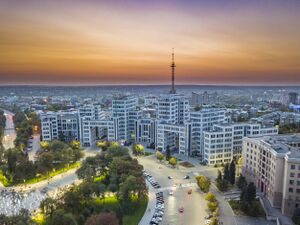
كما أشار بالتين إلى أن القمع القومي خلال الحرب العالمية الأولى قد ازداد وعانى منه الأوكرانيون بشكل خاص. [23] مع إعلان الحرب، تم إغلاق جميع الصحف والدوريات الناطقة باللغة الأوكرانية. [23] خلال "التراجع الكبير"، تمكن الاشتراكيون الديمقراطيون المحليون المؤيدون لأوكرانيا من الحصول على إذن لنشر صحيفة "سلوفو" الأوكرانية الناطقة بالأوكرانية. [23] كانت أول صحيفة باللغة الأوكرانية بعد عام من التوقف. [23] لكن سرعان ما فرضت إدارة المدينة غرامة على ناشر الصحيفة، وبعد ذلك لم يرغب أي ناشر آخر في طباعة الصحيفة. [23]
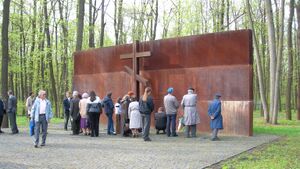
عندما أعلنت تسنترالنا رادا (المجلس المركزي لأوكرانيا) إنشاء جمهورية أوكرانيا الشعبية في نوفمبر 1917، تصورت أن تكون محافظة سلوبودا أوكرانيا جزءاً منها. [1] في ديسمبر 1917، أصبحت خاركيف أول مدينة في أوكرانيا احتلها قوات السوفيتية بقيادة ڤلاديمير أنتونوڤ-أوڤسنكو. [24] انتقل البلاشڤة في تسنترالنا رادا إلى خاركيف بعد فترة وجيزة لجعلها معقلهم وشكلوا رادا أو مجلس خاص بهم في 13 ديسمبر 1917. [24][25] بحلول فبراير 1918 كانت القوات البلشفية قد استولت على جزء كبير من أوكرانيا. [26]
في فبراير 1918، أصبحت خاركيف عاصمة جمهورية دونيتسك كرڤوي روگ السوڤيتية؛ لكن هذا الكيان تم حله بعد ستة أسابيع. [27] في أبريل 1918 ، احتل الجيش الألماني خاركيف. [28]ووفقاً لـ معاهدة برست لتوڤسك بين جمهورية أوكرانيا الشعبية وقوى المركز أصبحت جزءاً من جمهورية أوكرانيا الشعبية، وفقاً لما ورد في فبراير 1918. [29] في أوائل يناير 1919 استولت القوات البلشفية على خاركيف. [17] في منتصف يونيو 1919، استولى جيش التطوع من الحركة البيضاء التابع لـ أنطون دينكن على المدينة.[30] في ديسمبر 1919، استعاد الجيش الأحمر البلشفي خاركيف.[31]
قبل تشكيل الاتحاد السوڤيتي، أنشأ البلاشڤة خاركيڤ باعتبارها عاصمة لجمهورية أوكرانيا الاشتراكية السوڤيتية (من عام 1919 إلى 1934) في مواجهة جمهورية أوكرانيا الشعبية وعاصمتها كييڤ. [32]
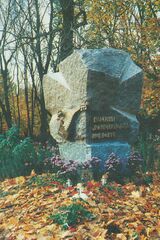
وفقاً للعالم اللغوي جورج شڤلوڤ، في أوائل العشرينات من القرن الماضي، كانت حصة المدارس الثانوية التي تدرس باللغة الأوكرانية أقل من نسبة السكان الأوكرانية العرقيين في اوبلاست خاركيڤ،[33] على الرغم من أن الاتحاد السوڤيتي قد أمر بأن تكون جميع المدارس في جمهورية أوكرانيا الاشتراكية السوڤيتية تتحدث الأوكرانية (كجزء من سياسة الأكرنة).[34]
كعاصمة للبلاد، خضعت لتوسع مكثف مع تشييد المباني لإيواء الحكومة والإدارة السوفيتية الأوكرانية المنشأة حديثاً. كان درژپروم ثاني أطول مبنى في أوروبا وأطول مبنى في الاتحاد السوفيتي في ذلك الوقت بارتفاع 63 metres (207 ft).[35] في عشرينيات القرن الماضي ، تم بناء برج راديو الخشبي 150 metres (490 ft) فوق المبنى. تأسس معهد رونتجن في عام 1931. [36] خلال فترة ما بين الحربين العالميتين، شهدت المدينة انتشار الهندسة المعمارية البنائية. [13]
كان أحد أفضل من يمثلها هو درژپروم الذي سبق ذكره، ومبنى الجيش الأحمر، ومعهد البوليتكنيك الأوكراني للتعليم عن بعد (UZPI)، ومبنى مجلس المدينة، ببرجه الضخم غير المتماثل، والمتجر المركزي الذي تم افتتاحه في الذكرى الخامسة عشرة لثورة أكتوبر. [13] في نفس العام في 7 نوفمبر 1932، تم تحويل مبنى جمعية النبلاء إلى مبنى اللجنة التنفيذية المركزية لعموم أوكرانيا. [13][37][38]
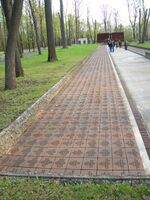
في عام 1928 ، بدأت عملية SVU ( الاتحاد من أجل حرية أوكرانيا) وعُقدت جلسات المحكمة في مبنى أوبرا خاركيف (الآن فيلهارمونيا). تم القبض على المئات من المثقفين الأوكرانيين وترحيلهم.[بحاجة لمصدر]
في أوائل الثلاثينيات من القرن الماضي، أدت المجاعة هولودومور إلى نزوح العديد من الناس عن الأرض إلى المدن، وإلى خاركيف على وجه الخصوص، بحثاً عن الطعام. وتوفي كثير من الناس ودُفنوا سرا في مقابر جماعية في مقابر تحيط بالمدينة.[بحاجة لمصدر]
في عام 1934، تم اعتقال وإعدام المئات من الكتاب والمفكرين والعاملين في مجال الثقافة الأوكرانيين في محاولة للقضاء على جميع بقايا القومية الأوكرانية في الفن. استمرت عمليات التطهير حتى عام 1938. كما تم جمع موسيقيي الشوارع الأوكرانيين المكفوفين كوبزار في خاركيف وقتلتهم المفوضية الشعبية للشؤون الداخلية (NKVD). [39] في يناير 1934 تم نقل عاصمة جمهورية أوكرانيا الاشتراكية السوفياتية من خاركيف إلى كييف. [10]
خلال شهري أبريل ومايو 1940 تم إعدام حوالي 3900 سجين بولندي من محتشد ستاروبلسك في مبنى المفوضية الشعبية للشؤون الداخلية (NKVD) في خاركيف، ودُفنوا لاحقاً سراً على أرض أحد منشآت NKVD في غابة پياتيخاتكي (جزء من مجزرة كاتين) على مشارف خاركيف.[40] يحتوي الموقع أيضاً على جثث عديدة لعمال مثقفين أوكرانيين تم اعتقالهم وإطلاق النار عليهم في عمليات التطهير الستالينية عام 1937-1938.
. . . . . . . . . . . . . . . . . . . . . . . . . . . . . . . . . . . . . . . . . . . . . . . . . . . . . . . . . . . . . . . . . . . . . . . . . . . . . . . . . . . . . . . . . . . . . . . . . . . . . . . . . . . . . . . . . . . . . . . . . . . . . . . . . . . . . . . . . . . . . . . . . . . . . . . . . . . . . . . . . . . . . . . .
الاحتلال الألماني
During World War II, Kharkiv was the site of several military engagements (see below). The city was captured by Nazi Germany on 24 October 1941.[41][42] There was a disastrous Red Army offensive that failed to capture the city in May 1942.[43][44]
The city was successfully retaken by the Soviets on 16 February 1943. It was captured for a second time by the Germans on 15 March 1943. It was then finally retaken on 23 August 1943.
Seventy percent of the city was destroyed and tens of thousands of the inhabitants were killed.[بحاجة لمصدر] Kharkiv, the third largest city in the Soviet Union, was the most populous city in the Soviet Union captured by the Germans, since in the years preceding World War II, Kyiv was by population the smaller of the two.
The significant Jewish population of Kharkiv (Kharkiv's Jewish community prided itself with the second largest synagogue in Europe) suffered greatly during the war. Between December 1941 and January 1942, an estimated 15,000 Jews were killed and buried in a mass grave by the Germans in a ravine outside of town named Drobytsky Yar.[45]
During World War II, four battles took place for control of the city:
- First Battle of Kharkov
- Second Battle of Kharkov
- Third Battle of Kharkov
- Fourth Battle of Kharkov (see also Operation Polkovodets Rumyantsev)
Before the occupation, Kharkiv's tank industries were evacuated to the Urals with all their equipment, and became the heart of Red Army's tank programs (particularly, producing the T-34 tank earlier designed in Kharkiv). These enterprises returned to Kharkiv after the war, and continued to produce tanks.
Of the population of 700,000 that Kharkiv had before the start of World War II, 120,000 became Ost-Arbeiter (slave worker) in Germany, 30,000 were executed and 80,000 starved to death during the war.[17]
ما بعد الحرب العالمية الثانية
In the post-World War II period, many of the destroyed homes and factories were rebuilt. The city was planned to be rebuilt in the style of Stalinist Classicism.[13]
From 1961 to 1975, the Kharkov Highest Artillery School of Engineering existed for the RVSN (Strategic Rocket Forces).[46]
An airport was built in 1954. Following the war, Kharkiv was the third largest scientific and industrial centre in the former USSR (after Moscow and Leningrad).
In 1975, the Kharkiv subway was opened.
في أوكرانيا المستقلة
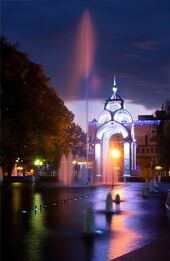
By its territorial expansion on September 6, 2012, the city increased its area from about 310 to 350 square kilometres (120 to 140 sq mi).[47]
A well-known landmark of Kharkiv is the Freedom Square (Ploshcha Svobody formerly known as Dzerzhinsky Square), which is the ninth largest city square in Europe, and the 28th largest square in the world.
There is an underground rapid-transit system (metro) with about 38.7 km (24 mi) of track and 30 stations. The newest underground station, Peremoha, was opened on 19 August 2016.[48] All the underground stations have very distinctive architecture.
Kharkiv was a host city for UEFA Euro 2012, and hosted three group soccer matches at the reconstructed Metalist Stadium.
Many orthodox churches were built in Kharkiv in the 1990s and 2000s.[بحاجة لمصدر] For example, Church of Myrrh-bearing Women, Church of St. Vladimir, Church of St. Tamara, etc.
In 2006 an improvised explosive device exploded near a supermarket.[49]
In 2007, the city's Vietnamese minority built the largest Buddhist temple in Europe on a 1 hectare plot with a monument to Ho Chi Minh.[50]
Gorky Park was fully renovated in the 2000s, having a big number of modern attractions, a lake with lilies and sport facilities to play tennis, football, beach volleyball, and basketball.
Feldman Park was created in recent years, containing a big collection of animals, horses, etc.
A judge and his family was decapitated in 2012 in the Kharkiv beheadings.[51]
القلاقل الممالئة لروسيا 2014
The Euromaidan protests in the winter of 2013–2014 against then president Viktor Yanukovych consisted of daily gatherings of about 200 protestors near the statue of Taras Shevchenko end were predominantly peaceful.[52] Pro-Yanukovych demonstrations, held near the statue of Lenin, were similarly small.[52]
The 2014 pro-Russian unrest in Ukraine affected Kharkiv but to a lesser extent than in neighbouring Donbass, where tensions led to armed conflict.[53] On 2 March 2014, a Russian "tourist" from Moscow replaced the Ukrainian flag with a Russian flag on the Kharkiv regional state administration building.[54] On 6 April 2014 pro-Russian protestors occupied the building and unilaterally declared independence from Ukraine as the "Kharkov People's Republic".[52][55]
The uprising was quelled in less than two days due to rapid reaction of the Ukrainian security forces under then Ukrainian Interior Minister Arsen Avakov and Stepan Poltorak the then acting commander of the Ukrainian Internal Forces.[52][56] A special forces unit from Vinnytsia was sent to the city to crush the separatists.[52] Doubts arose about the local origin of the protestors after they initially stormed an opera and ballet theatre believing it was the city hall.[57]
On 13 April, some pro-Russian protesters again made it inside the Kharkiv regional state administration building.[58] Later on 13 April, the building permanently returned to full Ukrainian control.[55][56][58][59][60][61][62] Violent clashes resulted in the severe beating of at least 50 pro-Ukrainian protesters in attacks by pro-Russian protesters.[58][61]
The mayor of the city, Hennadiy Kernes, who supported the Orange Revolution but later joined the Party of Regions, decided to side with the Ukrainian government.[52]
Kharkiv returned to relative calm by 30 April.[63] Relatively peaceful demonstrations continued to be held, with "pro-Russian" rallies gradually diminishing and "pro-Ukrainian unity" demonstrations growing in numbers.[64][65][66] On 28 September, activists dismantled Ukraine's largest monument to Lenin at a pro-Ukrainian rally in the central square.[67] Polls conducted from September to December 2014 found little support in Kharkiv for joining Russia.[68][69]
From early November until mid-December, Kharkiv was struck by seven non-lethal bomb blasts. Targets of these attacks included a rock pub known for raising money for Ukrainian forces, a hospital for Ukrainian forces, a military recruiting centre, and a National Guard base.[70] According to SBU investigator Vasyliy Vovk, Russian covert forces were behind the attacks, and had intended to destabilize the otherwise calm city of Kharkiv.[71]
On 8 January 2015 five men wearing balaclavas broke into an office of (the volunteer group aiding refugees from Donbass) Station Kharkiv.[72] Simultaneously with physical threats the men demanded to hear the political position of Station Kharkiv.[72] After having been given an answer, the men apologized and left.[72]
On Sunday 22 February 2015, an improvised explosive device in 2015 killed four people and wounded nine during a march commemorating the Euromaidan victims.[52] The authorities launched an 'anti-terrorist operation'.[73] Kharkiv has experienced more non-lethal small bombings since 22 February 2015 targeting army fuel tanks, an unoccupied passenger train and a Ukrainian flag in the city centre.[74]
On 23 September 2015, 200 people in balaclavas and camouflage picketed the house of former governor Mykhailo Dobkin, and then went to Kharkiv town hall, where they tried to force their way through the police cordon. At least one tear gas grenade was used. The rioters asked the mayor, Hennadiy Kernes, to come out.[75][76]
السنوات الأخيرة
Until 18 July 2020, Kharkiv was incorporated as a city of oblast significance and served as the administrative center of Kharkiv Raion though it did not belong to the raion. In July 2020, as part of the administrative reform of Ukraine, which reduced the number of raions of Kharkiv Oblast to seven, the city of Kharkiv was merged into Kharkiv Raion.[77][78]
A fire in 2021 killed 15 people.[79]
Kharkiv's Mayor for ten years, Hennadiy Kernes, died on 17 December 2020 in Berlin of COVID-19.[80][81] Ihor Terekhov of Kernes's party Kernes Bloc — Successful Kharkiv succeeded him in November 2021.[3][4] The City was invaded by Russia on February 23, 2022.
الجغرافيا
Kharkiv is located at the banks of the Kharkiv, Lopan, and Udy rivers, where they flow into the Seversky Donets watershed in the north-eastern region of Ukraine.
Historically, Kharkiv lies in the Sloboda Ukraine region (Slobozhanshchyna also known as Slobidshchyna) in Ukraine, in which it is considered to be the main city.
The approximate dimensions of city of Kharkiv are: from the North to the South — 24.3 km; from the West to the East — 25.2 km.
Based on Kharkiv's topography, the city can be conditionally divided into four lower districts and four higher districts.
The highest point above sea level in Pyatikhatky in Kharkiv is 202m, the lowest point above sea level in Novoselivka in Kharkiv is 94m.[بحاجة لمصدر]
Kharkiv lies in the large valley of rivers of Kharkiv, Lopan', Udy, and Nemyshlya. This valley lies from the North West to the South East between the Mid Russian highland and Donetsk lowland. All the rivers interconnect in Kharkiv and flow into the river of Northern Donets. A special system of concrete and metal dams was designed and built by engineers to regulate the water level in the rivers in Kharkiv.[بحاجة لمصدر]
Kharkiv has a large number of green city parks with a long history of more than 100 years with very old oak trees and many flowers.[بحاجة لمصدر] Gorky park, or Maxim Gorky Central Park for Culture and Recreation, is Kharkiv's largest public garden. The park has nine areas: children, extreme sports, family entertainment, a medieval area, entertainment center, French park, cable car, sports grounds, retro park.
. . . . . . . . . . . . . . . . . . . . . . . . . . . . . . . . . . . . . . . . . . . . . . . . . . . . . . . . . . . . . . . . . . . . . . . . . . . . . . . . . . . . . . . . . . . . . . . . . . . . . . . . . . . . . . . . . . . . . . . . . . . . . . . . . . . . . . . . . . . . . . . . . . . . . . . . . . . . . . . . . . . . . . . .
الطقس
Kharkiv's climate is humid continental (Köppen climate classification Dfa/Dfb) with cold, snowy winters and dry and hot summers.
The city has rather sunny, warm summers which, however, are relatively mild compared to temperatures in South European regions, due to the region's lower elevation, proximity to the Black Sea, and the city's latitude.
Kharkiv has relatively long and cold winters.
The average rainfall totals 519 mm (20 in) per year, with the most in June and July.
| بيانات مناخ Kharkiv, Ukraine (1991−2020, extremes 1936–present) | |||||||||||||
|---|---|---|---|---|---|---|---|---|---|---|---|---|---|
| الشهر | يناير | فبراير | مارس | أبريل | مايو | يونيو | يوليو | أغسطس | سبتمبر | اكتوبر | نوفمبر | ديسمبر | العام |
| العظمى القياسية °س (°ف) | 11.1 (52) |
14.6 (58.3) |
21.8 (71.2) |
30.5 (86.9) |
34.5 (94.1) |
39.8 (103.6) |
38.4 (101.1) |
39.8 (103.6) |
34.5 (94.1) |
29.3 (84.7) |
20.3 (68.5) |
13.4 (56.1) |
39٫8 (103٫6) |
| العظمى المتوسطة °س (°ف) | -2.1 (28.2) |
-0.8 (30.6) |
5.2 (41.4) |
14.7 (58.5) |
21.4 (70.5) |
25.2 (77.4) |
27.4 (81.3) |
26.8 (80.2) |
20.5 (68.9) |
12.6 (54.7) |
4.3 (39.7) |
-0.7 (30.7) |
12٫9 (55٫2) |
| المتوسط اليومي °س (°ف) | -4.5 (23.9) |
-3.8 (25.2) |
1.4 (34.5) |
9.7 (49.5) |
16.1 (61) |
20.0 (68) |
22.0 (71.6) |
21.1 (70) |
15.1 (59.2) |
8.2 (46.8) |
1.6 (34.9) |
-2.9 (26.8) |
8٫7 (47٫7) |
| الصغرى المتوسطة °س (°ف) | -6.8 (19.8) |
-6.6 (20.1) |
-1.9 (28.6) |
4.8 (40.6) |
10.7 (51.3) |
14.7 (58.5) |
16.6 (61.9) |
15.4 (59.7) |
10.2 (50.4) |
4.4 (39.9) |
-0.8 (30.6) |
-5.1 (22.8) |
4٫6 (40٫3) |
| الصغرى القياسية °س (°ف) | -35.6 (-32.1) |
-29.8 (-21.6) |
-32.2 (-26) |
-11.4 (11.5) |
-1.9 (28.6) |
2.2 (36) |
5.7 (42.3) |
2.2 (36) |
-2.9 (26.8) |
-9.1 (15.6) |
-20.9 (-5.6) |
-30.8 (-23.4) |
−35٫6 (−32٫1) |
| هطول mm (inches) | 37 (1.46) |
33 (1.3) |
36 (1.42) |
32 (1.26) |
54 (2.13) |
58 (2.28) |
63 (2.48) |
39 (1.54) |
44 (1.73) |
44 (1.73) |
39 (1.54) |
40 (1.57) |
519 (20٫43) |
| % Humidity | 85.6 | 83.0 | 77.3 | 65.7 | 60.9 | 65.2 | 65.3 | 62.9 | 70.2 | 77.6 | 85.7 | 86.5 | 73٫8 |
| Avg. rainy days | 10 | 8 | 10 | 13 | 14 | 15 | 13 | 10 | 12 | 13 | 13 | 12 | 143 |
| Avg. snowy days | 19 | 18 | 12 | 2 | 0.1 | 0 | 0 | 0 | 0.03 | 2 | 9 | 18 | 80 |
| Sunshine hours | 41.5 | 63.3 | 123.5 | 166.7 | 252.9 | 266.6 | 278.0 | 262.4 | 176.6 | 112.8 | 51.0 | 31.4 | 1٬826٫7 |
| Source #1: Pogoda.ru.net[82] | |||||||||||||
| Source #2: World Meteorological Organization (humidity and sun 1981–2010)[83] | |||||||||||||
خط الأفق
- Architecture in the city center of Kharkiv
الاقتصاد
The 2016–2020 economic development strategy: "Kharkiv Success Strategy", is created in Kharkiv.[84][85][86] Kharkiv has a diversified service economy, with employment spread across a wide range of professional services, including financial services, manufacturing, tourism, and high technology.
International Economic Forum
The International Economic Forum: Innovations. Investments. Kharkiv Innitiatives! is being conducted in Kharkiv every year.[87]
In 2015, the International Economic Forum: Innovations. Investments. Kharkiv Innitiatives! was attended by the diplomatic corps representatives from 17 world countries, working in Ukraine together with top-management of trans-national corporations and investment funds; plus Ukrainian People's Deputies; plus Ukrainian Central government officials, who determine the national economic development strategy; plus local government managers, who perform practical steps in implementing that strategy; plus managers of technical assistance to Ukraine; plus business and NGO's representatives; plus media people.[87][88][89][90][91]
The key topics of the plenary sessions and panel discussions of the International Economic Forum: Innovations. Investments. Kharkiv Innitiatives! are the implementation of Strategy for Sustainable Development "Ukraine – 2020", the results achieved and plan of further actions to reform the local government and territorial organization of power in Ukraine, export promotion and attraction of investments in Ukraine, new opportunities for public-private partnerships, practical steps to create "electronic government", issues of energy conservation and development of oil and gas industry in the Kharkiv Region, creating an effective system of production and processing of agricultural products, investment projects that will receive funding from the State Fund for Regional Development, development of international integration, preparation for privatization of state enterprises.[87][88][89][90][91]
International Industrial Exhibitions
The international industrial exhibitions are usually conducted at the Radmir Expohall exhibition center in Kharkiv.[92]
Industrial corporations
During the Soviet era, Kharkiv was the capital of industrial production in Ukraine and a large centre of industry and commerce in the USSR. After the collapse of the Soviet Union the largely defence-systems-oriented industrial production of the city decreased significantly. In the early 2000s, the industry started to recover and adapt to market economy needs. The enterprises form machine-building, electro-technology, instrument-making, and energy conglomerates.
State-owned industrial giants, such as Turboatom and Elektrotyazhmash[93] occupy 17% of the heavy power equipment construction (e.g., turbines) market worldwide. Multipurpose aircraft are produced by the Antonov aircraft manufacturing plant. The Malyshev factory produces not only armoured fighting vehicles, but also harvesters. Khartron[94] is the leading designer of space and commercial control systems in Ukraine and the former CIS.
IT industry
As of April 2018, there were 25,000 specialists in IT industry of the Kharkiv region, 76% of them were related to computer programming. Thus, Kharkiv accounts for 14% of all IT specialists in Ukraine and makes the second largest IT location in the country, right after the capital Kyiv.[95]
Also, the number of active IT companies in the region to be 445, five of them employing more than 601 people. Besides, there are 22 large companies with the workers' number ranging from 201 to 600. More than half of IT-companies located in the Kharkiv region fall into "extra small" category with less than 20 persons engaged. The list is compiled with 43 medium (81-200 employers) and 105 small companies (21-80).[بحاجة لمصدر]
Due to the comparably narrow market for IT services in Ukraine, the majority of Kharkiv companies are export-oriented with more than 95% of total sales generated overseas in 2017. Overall, the estimated revenue of Kharkiv IT companies will more than double from $800 million in 2018 to $1.85 billion by 2025. The major markets are North America (65%) and Europe (25%).[96]
صناعة التمويل
Kharkiv is also the headquarters of one of the largest Ukrainian banks, UkrSibbank, which has been part of the BNP Paribas group since December 2005.
التجارة
There are many large modern shopping malls in Kharkiv.
There are a large number of markets:
- Barabashovo market is the largest market in Ukraine and one of the largest markets in Europe.
- Blagoveshinskiy market.
- Konniy "horse" market.
- Sumskoi market [97]
- Raiskiy book market.
العلوم والتعليم
Higher education
The Vasyl N. Karazin Kharkiv National University is the most prestigious reputable classic university, which was founded due to the efforts by Vasily Karazin in Kharkiv in 1804–1805.[98][99] On 29 January [ن.ق. 17 January] 1805, the Decree on the Opening of the Imperial University in Kharkiv came into force.
The Roentgen Institute opened in 1931. It was a specialist cancer treatment facility with 87 research workers, 20 professors, and specialist medical staff. The facilities included chemical, physiology, and bacteriology experimental treatment laboratories. It produced x-ray apparatus for the whole country.[36]
The city has 13 national universities and numerous professional, technical and private higher education institutions, offering its students a wide range of disciplines. Kharkiv National University (12,000 students), National Technical University "KhPI" (20,000 students), Kharkiv National University of Radioelectronics (12,000 students), Kharkiv National Aerospace University "KhAI", Kharkiv National University of Economics, Kharkiv National University of Pharmacy, Kharkiv National Medical University are the leading[بحاجة لمصدر] universities in Ukraine.
More than 17,000 faculty and research staff are employed in the institutions of higher education in Kharkiv.
البحث العلمي
The city has a high concentration of research institutions, which are independent or loosely connected with the universities. Among them are three national science centres: Kharkiv Institute of Physics and Technology, Institute of Meteorology, Institute for Experimental and Clinical Veterinary Medicine and 20 national research institutions of the National Academy of Science of Ukraine, such as the B Verkin Institute for Low Temperature Physics and Engineering, Institute for Problems of Cryobiology and Cryomedicine, State Scientific Institution "Institute for Single Crystals", Usikov Institute of Radiophysics and Electronics (IRE), Institute of Radio Astronomy (IRA), and others. A total number of 26,000 scientists are working in research and development.
A number of world-renowned scientific schools appeared in Kharkiv, such as the theoretical physics school and the mathematical school.
There is the Kharkiv Scientists House in the city, which was built by A. N. Beketov, architect in Kharkiv in 1900. All the scientists like to meet and discuss various scientific topics at the Kharkiv Scientists House in Kharkiv.[100]
Public libraries
In addition to the libraries affiliated with the various universities and research institutions, the Kharkiv State Scientific V. Korolenko-library is a major research library.
Secondary schools
Kharkiv has 212 (secondary education) schools, including 10 lyceums and 20 gymnasiums.[بحاجة لمصدر]
المراكز التعليمية
There is the educational "Landau Center", which is named after Prof. L.D. Landau, Nobel laureate in Kharkiv.[101]
السكان
| تعداد السكان تاريخياً | ||
|---|---|---|
| الإحصاء | التعداد | %± |
| 1660 | 1,000[102] | |
| 1788 | 10,742[103] | |
| 1850 | 41,861[104] | |
| 1861 | 50,301[104] | |
| 1901 | 198,273[104] | |
| 1916 | 352,300[105] | |
| 1917 | 382,000[106] | |
| 1920 | 285,000[105] | |
| 1926 | 417,000[105] | +20.85% |
| 1939 | 833,000[107] | +1.99% |
| 1941 | 902,312[105] | |
| 1941 | 1,400,000[108] | |
| 1941 | 456,639[105][109] | |
| 1943 | 170,000[110] | |
| 1959 | 930,000[104] | +5.60% |
| 1962 | 1,000,000[104] | |
| 1976 | 1,384,000[104] | |
| 1982 | 1,500,000[103] | |
| 1989 | 1,593,970 | +1.67% |
| 1999 | 1,510,200 | -0.94% |
| 2001 | 1,470,900[111] | -0.97% |
المدن الشقيقة
 Belgorod, روسيا (2001)
Belgorod, روسيا (2001) بولونيا، إيطاليا (1966)
بولونيا، إيطاليا (1966) برنو، جمهورية التشيك (2005)
برنو، جمهورية التشيك (2005) Cetinje, Montenegro (2011)
Cetinje, Montenegro (2011) سنسيناتي، الولايات المتحدة (1989)
سنسيناتي، الولايات المتحدة (1989) Daejeon, South Korea (2013)
Daejeon, South Korea (2013) Daugavpils, Latvia (2006)
Daugavpils, Latvia (2006) Gaziantep, Turkey (2011)
Gaziantep, Turkey (2011) Geroskipou, Cyprus (2018)
Geroskipou, Cyprus (2018) Jinan, China (2004)
Jinan, China (2004) Kaunas, Lithuania (2001)
Kaunas, Lithuania (2001) Kutaisi, Georgia (2005)
Kutaisi, Georgia (2005) Lille, France (1978)
Lille, France (1978) Maribor, Slovenia (2012)
Maribor, Slovenia (2012) موسكو، روسيا (2001)
موسكو، روسيا (2001) سانت پطرسبورگ، روسيا
سانت پطرسبورگ، روسيا دونيتسك، أوكرانيا
دونيتسك، أوكرانيا Novosibirsk, Russia (2011)
Novosibirsk, Russia (2011) Nuremberg, Germany (1990)
Nuremberg, Germany (1990) Polis, Cyprus (2018)
Polis, Cyprus (2018) Poznań, Poland (1998)
Poznań, Poland (1998) Rishon LeZion, Israel (2008)
Rishon LeZion, Israel (2008) Saint Petersburg, Russia (2003)
Saint Petersburg, Russia (2003) Tbilisi, Georgia (2012)
Tbilisi, Georgia (2012) Tianjin, China (1993)
Tianjin, China (1993) Tirana, Albania (2017)
Tirana, Albania (2017) Trnava, Slovakia (2013)
Trnava, Slovakia (2013) Varna, Bulgaria (1995)
Varna, Bulgaria (1995)
حائزو جوائز نوبل وفيلدز
- ڤلاديمير درينفلد (رياضيات)
- سيمون كوزنتس (اقتصاد)
- لڤ لانداو (فيزياء)
- إليا مشنيكوڤ (علم الأحياء)
مشاهير من خاركيڤ
|
المواصلات
The city of Kharkiv is one of the largest transportation centers in Ukraine, which is connected to numerous cities of the world by air, rail and road traffic. The city has many transportation methods, including: public transport, taxis, railways, and air traffic.
المواصلات الداخلية
Being an important transportation center of Ukraine, Kharkiv itself contains many different transportation methods. Kharkiv's Metro is the city's rapid transit system, operating since 1975, it includes three different lines with 28 stations in total.[113] The Kharkiv buses carry about 12 million passengers annually, trolleybuses, tramways (which celebrated 100 years of service in 2006), and marshrutkas (private minibuses).
السكك الحديدية
The first railway connection of Kharkiv was opened in 1869. The first train to arrive in Kharkiv came from the north on 22 May 1869, and on 6 June 1869, traffic was opened on the Kursk–Kharkiv–Azov line. Kharkiv's passenger railway station was reconstructed and expanded in 1901, to be later destroyed in the Second World War. A new railway station was built in 1952.
Various railway transportation methods available in the city are the: inter-city railway trains, and elektrichkas (regional electric trains).
المواصلات الجوية
Kharkiv is served by an international airport which used to have about 200 flights a day, almost all of them being passenger flights. The Kharkiv Osnova International Airport was only recently granted international status. The airport itself is not large and is situated within the city boundaries, south from the city centre. Flights to Kiev and Moscow are scheduled daily. There are regular flights to Vienna and Istanbul, and several other destinations. Charter flights are also available. The former largest carrier of the Kharkiv Airport — Aeromost-Kharkiv — is not serving any regular destinations as of 2007. The Kharkiv North Airport is a factory airfield and was a major production facility for Antonov aircraft company.
الهامش والمصادر
- ^ أ ب ت ث ج What Makes Kharkiv Ukrainian, The Ukrainian Week (23 November 2014)
- ^ خطأ استشهاد: وسم
<ref>غير صحيح؛ لا نص تم توفيره للمراجع المسماةnmcrinK - ^ أ ب (in أوكرانية) Terekhov officially became the mayor of Kharkiv, Ukrayinska Pravda (11 November 2021)
- ^ أ ب (in أوكرانية) Kernes' bloc nominated Terekhov as a candidate for mayor, Ukrayinska Pravda (6 September 2021)
- ^ Ukraine's second Winter Olympics: one medal, some good performances, The Ukrainian Weekly (1 March 1998)
- ^ Kharkiv "never had eastern-western conflicts", Euronews (23 October 2014)
- ^ "Чисельність наявного населення України (التعداد الفعلي لأوكرانيا)" (PDF) (in الأوكرانية). مصلحة إحصائيات الدولة الأوكرانية. Retrieved 11 July 2021.
- ^ Государственный архив Харьковской области. Ф. Р-2982, оп. 2, дело 16, стр. 53–54 State archive of the Kharkiv oblast F. R-2982, op. 2, delo 16. pp. 53–54.
- ^ "Демоскоп Weekly – Приложение. Справочник статистических показателей". www.demoscope.ru. Retrieved 2021-08-11.
- ^ أ ب Liber, George (1992). Soviet Nationality Policy, Urban Growth, and Identity Change in the Ukrainian SSR, 1923–1934. Cambridge University Press. ISBN 978-0521522434.
- ^ Kevin Alan Brook, The Jews of Khazaria (2006), p. 34.
- ^ Roman Solchanyk (January 2001). Ukraine and Russia: The Post-Soviet Transition. Rowman & Littlefield. p. 6. ISBN 978-0-7425-1018-0. Retrieved 31 March 2015.
- ^ أ ب ت ث ج ح خ د ذ ر ز س ش ص ض ط ظ ع غ ف ق ك ل م ن هـ و ي أأ أب (in أوكرانية) Живий Харків. Нічна екскурсія містом-господарем (Living Kharkiv. Nightly excursion through the host-city) Ukrayinska Pravda. June 9, 2012
- ^ Ivan Katchanovski et al. (eds.), Historical Dictionary of Ukraine (2013), p. 253
- ^ "Сторінка:Котляревський. Енеида на малороссійскій языкъ перелицїованная. 1798.pdf/175 — Вікіджерела". uk.wikisource.org. Retrieved 18 June 2017.
- ^ Slavs in Canada, vol. 2, Inter-university Committee on Canadian Slavs (1968), p. 255.
- ^ أ ب ت Ukraine: A History 4th Edition by Orest Subtelny, University of Toronto Press, 2009, ISBN 1442609915
- ^ Указ об учреждении губерний и о росписании к ним городов, 1708 г., декабря 18 [Decree on the establishment of Provinces and cities assigned to them, December 18, 1708]. constitution.garant.ru (in الروسية). Retrieved 31 March 2015.
- ^ История административно-территориального деления воронежского края. 2. Воронежская губерния [History of the Administrative-Territorial Division of the Voronezh Region. 2. Voronezh Province.] (in الروسية). Archive service of Voronezh Oblast. Archived from the original on 25 May 2013. Retrieved 10 June 2012.
- ^ У Харкові відкрили меморіальну дошку Івану Франку [A memorial plaque to Ivan Franko was unveiled in Kharkiv] (in الأوكرانية). Istpravda.com.ua. 23 August 2011. Retrieved 21 July 2012.
- ^ Харків і харків'яни XIX-го сторіччя [Kharkiv and Kharkiv denizens in 19th century photos] (in الأوكرانية). Istpravda.com.ua. 24 January 2011. Retrieved 21 July 2012.
- ^ أ ب ت "Hromadas". Encyclopedia of Ukraine. Retrieved 14 January 2016.
- ^ أ ب ت ث ج ح خ د ذ ر ز Балтин, А. "Харьковская организация Р. С.-Д. Р. П. большевиков во время войны." // Летопись Революции. - 1923. No.5. С. 3-20
- ^ أ ب Historical Dictionary of Ukraine (Historical Dictionaries of Europe) by Ivan Katchanovski, Scarecrow Press (Publication date: July 11, 2013), ISBN 0810878453 (page 713)
- ^ Literary Politics in Soviet Ukraine, 1917–1934. Durham and London: Duke University Press. ISBN 0-8223-1099-6 (page 7)
- ^ World War I: A Student Encyclopedia. ABC-CLIO. p. 1195. ISBN 978-1-85109-879-8
- ^ Ukraine: The Phony War?, The New York Review of Books (27 April 2014)
- ^ Spies and Commissars: The Early Years of the Russian Revolution. PublicAffairs. ISBN 1-61039-140-3.
- ^ Borderlands into Bordered Lands: Geopolitics of Identity in Post-Soviet Ukraine (Soviet and Post-Soviet Politics and Society, Vol. 98) (Volume 98), Ibidem Verlag, 2010, ISBN 383820042X (page 24)
- ^ The Black Book of Communism: Crimes, Terror, Repression, Harvard University Press, 858 pages, ISBN 0-674-07608-7, page 97
- ^ The A to Z of the Russo-Japanese War. Scarecrow Press Inc. ISBN 978-0-8108-6841-0 (page 101)
- ^ "Донбас і Україна (з історії революційної боротьби 1917–18 рр.) (Donbas and Ukraine. (From articles and declarations of Mykola Skrypnyk))". Istpravda.com.ua. Retrieved 21 July 2012.
- ^ Games from the Past: The continuity and change of the identity dynamic in Donbas from a historical perspective , Södertörn University (May 19, 2014)
- ^ Language Policy in the Soviet Union by Lenore Grenoble, Springer Science+Business Media, 2003, ISBN 978-1-4020-1298-3 (page 84)
- ^ "Derzhprom statistics". Kharkov.ua. Retrieved 21 July 2012.
- ^ أ ب Khwaja, Barbara (26 May 2017). "Health Reform in Revolutionary Russia". Socialist Health Association. Retrieved 26 May 2017.
- ^ "Picture of the building in the Vsesvit magazine". Istpravda.com.ua. 2012-04-30. Retrieved 21 July 2012.
- ^ "Photos of the newspaper "Proletarian" for 1932-33". Istpravda.com.ua. Retrieved 21 July 2012.
- ^ Ukrainian minstrels: and the blind shall sing by Natalie Kononenko, M.E. Sharp, ISBN 0-7656-0144-3/ISBN 978-0-7656-0144-5, page 116
- ^ Fischer, Benjamin B., "The Katyn Controversy: Stalin's Killing Field", Studies in Intelligence, Winter 1999–2000, last accessed on 10 December 2005
- ^ "Харків часів "дорослого дитинства" Людмили Гурченко (Kharkiv at times of "matured childhood" of Lyudmila Gurchenko)". Istpravda.com.ua. Retrieved 21 July 2012.
- ^ "Kharkiv through the eyes of Lyudmila Gurchenko". Andersval.nl. 2011-03-31. Retrieved 15 July 2012.
- ^ The Red Army committed 765,300 men to this offensive, suffering 277,190 casualties (170,958 killed/missing/PoW, 106,232 wounded) and losing 652 tanks, and 4,924 guns and mortars. Glantz, David M., Kharkov 1942, anatomy of a military disaster through Soviet eyes, pub Ian Allan, 1998, ISBN 0-7110-2562-2 page 218.
- ^ per Robert M. Citino, author of "Death of the Wehrmacht", and other sources, the Red Army came to within a few miles of Kharkiv on 14 May 1942 by Soviet forces under Marshal Timoshenko before being driven back by German forces under Field Marshal Fedor von Bock, p. 100
- ^ Karpyuk, Gennady (23–29 December 2006), 49, http://www.dt.ua/3000/3150/55411/, retrieved on 16 December 2011
- ^ "High Command Strategic Rocket Forces (GK RVSN)". Retrieved 1 August 2021.
- ^ "Про зміну і встановлення меж міста Харків, Дергачівського і Харківського районів Харківської області". Search.ligazakon.ua. 2012-09-18. Retrieved 12 March 2013.
- ^ Kharkiv metro reaches 30 stations Kharkiv metro reaches 30 stations, Railway Gazette International (22 August 2016)
- ^ "Ukraine supermarket blasts injure 14 - unconfirmed reports". Interfax. 2006-04-22. Archived from the original on 2006-09-24. Retrieved 2007-01-08.
- ^ In↑ «Сегодня»,21 December 2007.
- ^ "Judge, Family Beheaded In Kharkiv". RadioFreeEurope/RadioLiberty (in الإنجليزية). Retrieved 2019-12-06.
"Beheaded body of Ukraine judge found in apartment". The Telegraph. Agence France-Presse. 16 December 2012. Archived from the original on 2022-01-11. Retrieved 2013-08-18. - ^ أ ب ت ث ج ح خ Ukraine Authorities Clear Kharkiv Building, Arrest Scores Of 'Separatists', Radio Free Europe (8 April 2014)
How Eastern Ukraine Is Adapting and Surviving: The Case of Kharkiv, Carnegie Europe (12 September 2018) - ^ "Ukraine crisis: Timeline". BBC News. 13 November 2014. Retrieved 22 March 2015.
- ^ Roth, Andrew (4 March 2014). "From Russia, 'Tourists' Stir the Protests". The New York Times.
"Russian site recruits 'volunteers' for Ukraine". BBC News. 4 March 2014. - ^ أ ب "Pro-Russia activists declare establishment of 'Kharkiv people's republic'". Focus Information Agency. 7 April 2014. Retrieved 13 April 2014.
- ^ أ ب "Kharkiv settles down, while pro-Russian separatists still hold buildings in Luhansk, Donetsk". Kyiv Post. 8 April 2014. Retrieved 13 April 2014.
- ^ "Protesters Storm Kharkiv Theater Thinking It Was City Hall". The Moscow Times. 8 April 2014.
- ^ أ ب ت "Kharkiv city government building infiltrated by pro-Russian protesters". Kyiv Post. 13 April 2014. Retrieved 13 April 2014.
- ^ "Кернес пообіцяв допомогти звільнити затриманих сепаратистів | Українська правда". Pravda.com.ua. Retrieved 28 April 2014.
- ^ Kharkiv torn between Europe and Russia, Deutsche Welle (6 March 2014)
- ^ أ ب "После нападения антимайдановцев на митинг Евромайдана в Харькове пострадало 50 человек : Новости УНИАН". Unian.net. 14 April 2014. Retrieved 28 April 2014.
- ^ "Latest from the Special Monitoring Mission in Ukraine". Organisation for Security and Co-operation in Europe. 14 April 2014. Archived from the original on 16 April 2014. Retrieved 16 April 2014.
- ^ "Latest from the Special Monitoring Mission in Ukraine – based on information received up until 29 April 2014" (Press release). Organization for Security and Co-operation in Europe. 30 April 2014. Retrieved 1 May 2014.
- ^ "Latest from the Special Monitoring Mission in Ukraine based on information received until 23 June 2014" (Press release). Organization for Security and Co-operation in Europe. 24 June 2014. Archived from the original on 22 November 2015. Retrieved 22 August 2014.
- ^ "Latest from the Special Monitoring Mission (SMM) in Ukraine based on information received until 18:00 hrs, 23 July" (Press release). Organization for Security and Co-operation in Europe. 24 July 2014. Retrieved 25 July 2014.
- ^ (in أوكرانية) Two liberty square rally, Status quo (17 August 2014)
- ^ Ukrainian Crowds Topple Lenin Statue (Again). Retrieved 29 September 2014.
- ^ خطأ استشهاد: وسم
<ref>غير صحيح؛ لا نص تم توفيره للمراجع المسماةDT150103 - ^ Seven recent blasts in Ukraine city stir fear of new Russian menace, Los Angeles Times (11 December 2014)
Mysterious spate of bombings hit Ukraine military hub, Agence France-Presse (10 December 2014) - ^ SBU: Russian special services target Kharkiv, Odesa, situation difficult to control, Ukrainian Independent Information Agency (10 December 2014)
- ^ أ ب ت Міліція з ясовує, хто напав на волонтерську "Станцію Харків" [Police finds out who attacked the volunteer-run "Station Kharkiv"] (in الأوكرانية). ukrinform.ua. 9 January 2015. Retrieved 22 March 2015."Станция Харьков" — первый пункт помощи переселенцам из зоны АТО ["Station Kharkiv" - the first point of assistance for displaced persons from the Donbass zone] (in الروسية). 24tv.ua. 25 October 2014. Retrieved 22 March 2015.
- ^ UNIAN Anti-terrorist operation launched in Kharkiv due to fatal blast on Sunday – Turchynov, 22 February 2015.
En.Censor.Net, Anti-terrorist operation started in Kharkiv: four participants on the explosion detained, 22 February 2015.
Novorossia.Today, Turchinov announced start of the ATO in Kharkov. The highest level of terrorist threat had been introduced in the city, 23 February 2015. - ^ Bomb Attacks Increase In Ukraine's Second-Largest City, Kharkiv, NPR (6 April 2015)
Kharkiv explosion targeting Ukrainian flag classified as 'terrorist act', Ukraine Today (7 April 2015)
Explosion In Ukraine's Kharkiv Targets National Flag Memorial, Radio Free Europe/Radio Liberty (7 April 2015) - ^ Unian, Over 200 men in balaclavas brawl at Kharkiv town hall, clash with police, 23 September 2015, 14:10.
- ^ Korrespondent, Появилось видео столкновений у горсовета Харькова [Video of riot at Kharkov City Council], 23 September 2015 17:40
- ^ "Про утворення та ліквідацію районів. Постанова Верховної Ради України № 807-ІХ". Голос України (in الأوكرانية). 2020-07-18. Retrieved 2020-10-03.
- ^ "Нові райони: карти + склад" (in Ukrainian). Міністерство розвитку громад та територій України. 17 July 2020.
{{cite web}}: CS1 maint: unrecognized language (link) - ^ "At least 15 killed, 11 injured in nursing home fire in Ukraine". Reuters. 21 January 2021. Retrieved 21 January 2021.
Kennedy, Rachael (21 January 2021). "Nursing home blaze in Ukraine kills at least 15 people". Euronews. Retrieved 21 January 2021. - ^ Kharkiv mayor Kernes dies, Ukrinform (17 December 2020)
Помер Геннадій Кернес: мер Харкова, який виграв вибори з реанімації, BBC Ukrainian (17 December 2020) (in أوكرانية) - ^ (in أوكرانية) Keys to cities. What is the secret of longevity of mayors, The Ukrainian Week (10 August 2020)
- ^ "Weather and Climate - The Climate of Kharkiv" (in الروسية). Weather and Climate (Погода и климат). Archived from the original on 13 December 2019. Retrieved 8 November 2021.
- ^ "World Meteorological Organization Climate Normals for 1981–2010". World Meteorological Organization. Archived from the original on 17 July 2021. Retrieved 18 July 2021.
- ^ "Розробка стратегії розвитку міста Харкова на 2016-2020 роки "Харків – стратегія успіху"". strategy.kharkov.ua. Retrieved 18 June 2017.
- ^ "Круглий стіл "Розробка Стратегії розвитку міста Харкова до 2020 року: наука і освіта" >> ХНУ імені В. Н. Каразіна". univer.kharkov.ua. Retrieved 18 June 2017.
- ^ Hulu LLC. "В університеті Каразіна обговорять перспективи розвитку освіти". city.kharkov.ua. Retrieved 18 June 2017.
- ^ أ ب ت "www.led.org.ua/en/". led.org.ua. Archived from the original on 9 August 2016. Retrieved 18 June 2017.
- ^ أ ب "VII International economic forum "INNOVATIONS. INVESTMENTS. KHARKIV INITIATIVES!" - Announcements - Embassy of Ukraine in the United States of America". usa.mfa.gov.ua. Retrieved 18 June 2017.
- ^ أ ب http://www.kmu.gov.ua/control/publish/article?art_id=247530844%7Cpublisher=kmu.gov.ua
- ^ أ ب "statements/amb-kharkiv-econ-forum-09042015". ukraine.usembassy.gov. Archived from the original on 7 January 2017. Retrieved 18 June 2017.
- ^ أ ب "Kharkiv – U.S. Embassy Kyiv Blog". usembassykyiv.wordpress.com. Retrieved 18 June 2017.
- ^ "Radmir Expohall | Radmir Expohall". radmir-expohall.com.ua. Retrieved 18 June 2017.
- ^ "spetm.com.ua". spetm.com.ua. Archived from the original on 28 September 2008. Retrieved 20 April 2012.
- ^ "Hartron: Forms of cooperation". hartron.com.ua. Retrieved 22 March 2015.
- ^ "Kharkiv". Kharkiv. Retrieved 2019-06-13.
- ^ "Kharkiv". Kharkiv. Retrieved 2019-06-13.
- ^ "Торговый центр "Сумской рынок" по адресу Харьков, Шевченковский район, Культуры, 8". kharkov.info. Retrieved 18 June 2017.
- ^ "Харківський національний університет імені В. Н. Каразіна". univer.kharkov.ua. Retrieved 18 June 2017.
- ^ "Харківський національний університет імені В.Н. Каразіна". vnz.univ.kiev.ua. Archived from the original on 27 August 2016. Retrieved 18 June 2017.
- ^ "house". khdu.org. Archived from the original on 27 July 2016. Retrieved 18 June 2017.
- ^ "ПРО "ЛАНДАУЦЕНТР" |". landaucentre.org. Retrieved 18 June 2017.
- ^ Л.И. Мачулин. Mysteries of the underground Kharkiv. — Х.: 2005. ISBN 966-87-68-00-0 (بالروسية)
- ^ أ ب Kharkiv: Architecture, monuments, renovations: Travel guide. Ed. А. Лейбфрейд, В. Реусов, А. Тиц. — Х.: Прапор, 1987(بالروسية)
- ^ أ ب ت ث ج ح Н.Т. Дьяченко. Streets and squares of Kharkiv. - X.: Прапор, 1977(بالروسية) خطأ استشهاد: وسم
<ref>غير صالح؛ الاسم "Дяченко" معرف أكثر من مرة بمحتويات مختلفة. خطأ استشهاد: وسم<ref>غير صالح؛ الاسم "Дяченко" معرف أكثر من مرة بمحتويات مختلفة. - ^ أ ب ت ث ج А.В. Скоробогатов. Kharkiv in times of German occupation (1941-1943). - X.: Прапор, 2006. ISBN 966-7880-79-6(اوكرانية) خطأ استشهاد: وسم
<ref>غير صالح؛ الاسم "Скоробогатов" معرف أكثر من مرة بمحتويات مختلفة. - ^ Oleksandr Leibfreid, Yu. Poliakova. Kharkiv. From fortress to capital. - Х.: Фолио, 2004(بالروسية)
- ^ State archives of Kharkiv Oblast. Ф. Р-2982, оп. 2, file 16, pp 53-54
- ^ Colonel Н. И. Рудницкий. Военкоматы Харькова в предвоенные и военные годы.(بالروسية)
- ^ In reference to the German census of December 1941; without children and teenagers no older 16 years of age; numerous city-dwellers evaded the registration(بالروسية)
- ^ Mykyta Khruschev. Report to ЦК ВКП(б) of August 30 1943. History: without «white spots». Kharkiv izvestia, № 100—101, August 23 2008, page 6(بالروسية)
- ^ Ukrainian Census (2001)
- ^ "Sister cities of Kharkov". kharkov.vbelous.net (in Russian). Retrieved May 4 2007.
{{cite web}}: Check date values in:|accessdate=(help); Unknown parameter|dateformat=ignored (help)CS1 maint: unrecognized language (link) - ^ "Metro. Basic facts" (in Russian). Retrieved May 4 2007.
{{cite web}}: Check date values in:|accessdate=(help); Text "workGortransport Kharkov" ignored (help)CS1 maint: unrecognized language (link)
وصلات خارجية
- عامة
- citynet.kharkov.ua — Official website of Kharkiv City Information Center (اوكرانية)/(بالروسية)
- city.kharkov.ua — Official website of Kharkiv City Council (اوكرانية)/(بالروسية)
- vecherniy.kharkov.ua — Newspaper "Evening Kharkiv" (اوكرانية)/(بالروسية)
- Kharkov city portal (اوكرانية)/(بالروسية)
- Your beloved Kharkov — Kharkiv city portal (اوكرانية)/(بالروسية)
- KHARKIV ZA JAZZ FEST — official web-site of International kharkiv jazz festival KHARKIV ZA JAZZ FEST.
- gortransport.kharkov.ua — Transport in Kharkiv (اوكرانية)/(بالروسية)
- Old Kharkov Gallery — Photos and postcards
- خرائط
- karta.kharkov.ua — Interactive Map
- Articles with أوكرانية-language sources (uk)
- CS1 الأوكرانية-language sources (uk)
- CS1 uses الروسية-language script (ru)
- CS1 الروسية-language sources (ru)
- CS1 uses الأوكرانية-language script (uk)
- Articles with Ukrainian language external links
- CS1 errors: unsupported parameter
- CS1 errors: unrecognized parameter
- Short description is different from Wikidata
- Articles with hatnote templates targeting a nonexistent page
- Missing redirects
- Pages using multiple image with auto scaled images
- Coordinates on Wikidata
- Articles containing أوكرانية-language text
- Articles containing روسية-language text
- Articles with unsourced statements from July 2016
- مقالات ذات عبارات بحاجة لمصادر
- Articles with unsourced statements from November 2017
- Articles with unsourced statements from May 2017
- Articles with unsourced statements from March 2017
- Articles with unsourced statements from November 2016
- Articles with unsourced statements from October 2016
- خاركيڤ
- أوبلاست خاركيڤ
- مدن اوكرانيا
- مستوطنات تأسست في 1654

